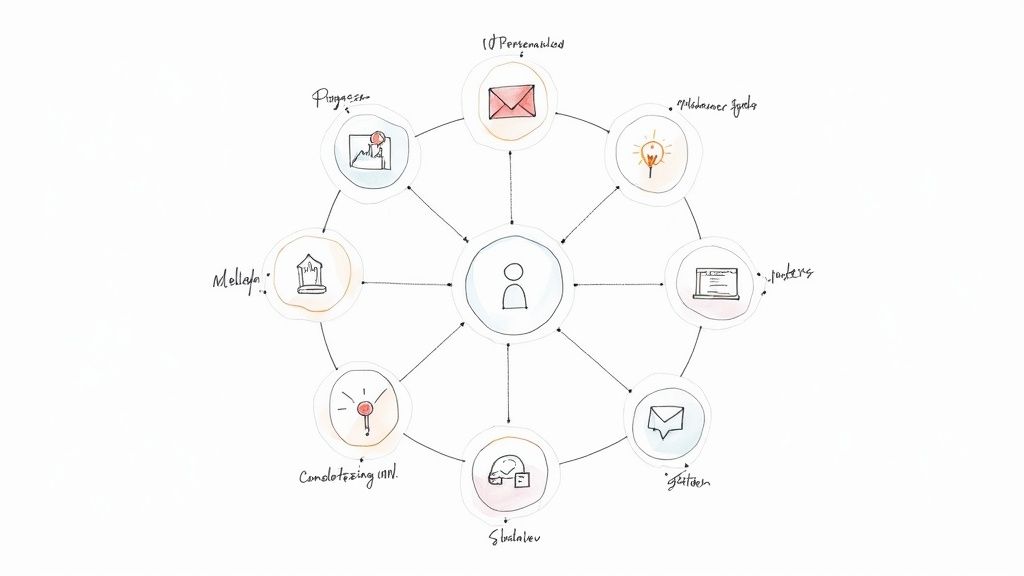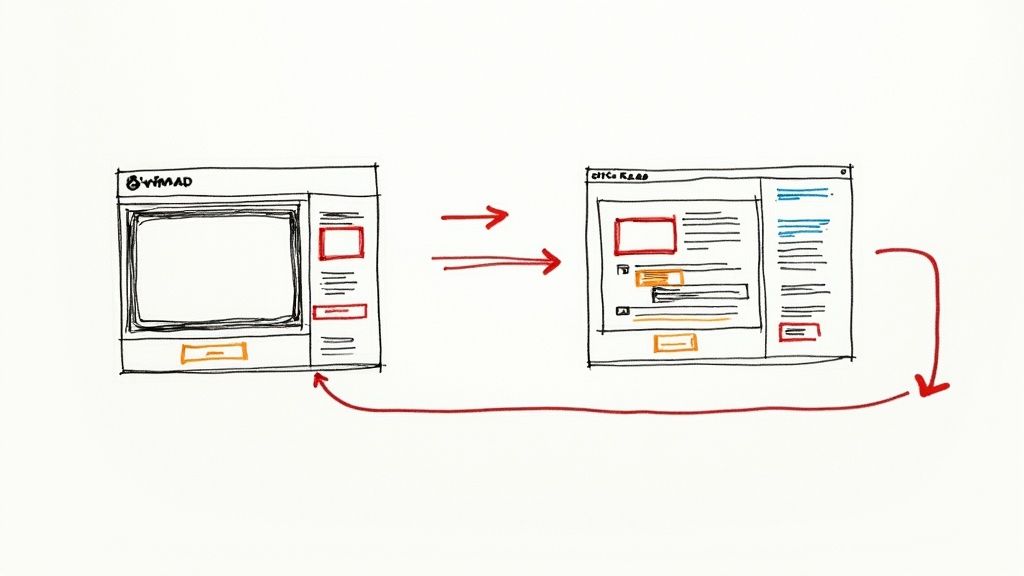
10 Customer Onboarding Best Practices for 2025
The first few moments after a customer signs up are the most critical in their entire lifecycle. A generic 'welcome' email and a feature-dump tour no longer cut it. Today's users expect an onboarding experience that is as intuitive, personalized, and valuable as the product itself. Failing at this first hurdle is the fastest way to increase churn and waste acquisition spend, making a structured approach essential. To ensure a smooth and effective first impression, a comprehensive Client Onboarding Checklist can be an invaluable tool for systematically covering all essential steps.
This guide moves beyond foundational checklists to explore the advanced customer onboarding best practices that transform new users into lifelong advocates. We will dive deep into actionable strategies, real-world examples from leading companies, and data-backed frameworks designed for immediate implementation. This isn't just about showing users how to use your product; it's about guiding them to their first "aha!" moment and demonstrating value as quickly as possible.
You will learn how to:
- Create personalized welcome journeys that resonate with individual user goals.
- Leverage progressive disclosure to avoid overwhelming new customers.
- Implement interactive walkthroughs that drive genuine engagement.
- Use data to continuously refine and optimize your onboarding flow.
By mastering these techniques, you can build a process that not only retains customers but also becomes a significant engine for sustainable growth. Let's explore the strategies that create truly exceptional first impressions.
1. Personalized Welcome Journey
A personalized welcome journey is one of the most impactful customer onboarding best practices because it immediately demonstrates that you understand the user's unique context and goals. Instead of a generic, one-size-fits-all tutorial, this approach tailors the initial experience based on key user attributes. By segmenting new customers by their role, industry, company size, or self-declared goals, you can deliver targeted guidance that feels instantly relevant and valuable.
This proactive customization dramatically reduces the time it takes for a user to experience their "aha!" moment, where they truly grasp the product's value proposition for their specific needs. It's the difference between a new user feeling overwhelmed by a sea of features and feeling guided toward the exact tools that will solve their problem.
How Personalization Drives Engagement
Leading platforms excel at this. Slack, for instance, customizes its setup process based on team size and intended use, guiding a small startup differently than a large enterprise. Similarly, HubSpot provides distinct onboarding tracks for marketers, salespeople, and service professionals, ensuring each user learns the CRM features most critical to their role. This targeted approach prevents confusion and accelerates product adoption.
To track the effectiveness of your personalized onboarding, it's crucial to monitor metrics that reflect user engagement and success within each segment.
The infographic below highlights three critical metrics for evaluating a personalized welcome journey.

Tracking these KPIs by segment reveals how effectively your onboarding addresses the needs of different user groups, allowing for data-driven adjustments.
Actionable Tips for Implementation
- Start Small: Begin by identifying 2-3 primary user segments. You can expand later, but starting small makes implementation manageable.
- Use Progressive Disclosure: Avoid overwhelming users. Reveal features and information gradually as they become relevant to the user's journey.
- Create Feedback Loops: Use surveys and in-app prompts to ask users if the onboarding was helpful, then use that data to refine your segmentation and content.
- Leverage Interactive Content: Using dynamic content can significantly boost engagement. You can create personalized video experiences that drive action by tailoring tutorials or welcome messages based on user data.
2. Progressive Disclosure and Gradual Feature Introduction
Progressive disclosure is a cornerstone of effective customer onboarding best practices, focusing on introducing complexity gradually. Instead of overwhelming new users with every feature at once, this method strategically reveals functionality as the user becomes more competent and their needs evolve. This approach respects the user's learning curve, building confidence by ensuring they master foundational elements before moving on to more advanced tools.
This deliberate, staged introduction is crucial for preventing cognitive overload, a common reason for user churn. When a user feels capable and in control from their very first session, they are far more likely to remain engaged and explore the full depth of your product. It’s the difference between being handed a cluttered, intimidating cockpit and learning to fly with a simple, step-by-step guide.
How Gradual Introduction Builds Mastery
Leading applications masterfully use this technique. Duolingo unlocks new grammar concepts and vocabulary sets only after a user demonstrates proficiency at the current level, creating a natural learning progression. Similarly, a design tool like Figma first introduces users to basic shapes and text tools, holding back advanced features like components and auto layout until they are contextually relevant. This prevents new designers from feeling intimidated and encourages exploration.
By mapping your feature set to a logical user journey, you guide users from initial success to long-term expertise, significantly boosting retention.
Actionable Tips for Implementation
- Map Features to User Milestones: Align feature introductions with key user achievements or "aha!" moments, not just a set timeline.
- Use Contextual Triggers: Reveal new features based on user actions. For example, introduce advanced filtering options only after a user has created a sufficient amount of content to filter.
- Provide an 'Advanced Mode': Allow power users or those with prior experience to bypass the guided introduction and access all features immediately.
- Create Clear Progress Indicators: Use checklists, progress bars, or visual cues to show users what they’ve learned and what’s coming next, creating a sense of accomplishment and anticipation.
3. Interactive Product Tours and Guided Walkthroughs
Interactive product tours are a cornerstone of modern customer onboarding best practices because they transform passive learning into an active, hands-on experience. Instead of forcing users to read lengthy documentation or watch non-interactive videos, guided walkthroughs prompt them to click, type, and navigate through core workflows directly within the application. This "learn by doing" approach helps users build muscle memory and gain confidence from their very first session.
By guiding users through key tasks with step-by-step instructions and contextual tooltips, you can effectively demonstrate the product’s value in a tangible way. This method significantly shortens the path to the "aha!" moment, as users don't just see what the product can do; they experience it themselves.

How Guided Experiences Accelerate Adoption
Many top-tier platforms use interactive tours to great effect. Airtable, for example, guides new users through creating their first base using relevant sample data, making an abstract concept immediately concrete. Similarly, Calendly’s setup walkthrough includes a live preview, allowing users to see the direct impact of their scheduling choices in real-time. This immediate feedback loop solidifies understanding and encourages completion.
This technique, popularized by digital adoption platforms like Appcues and WalkMe, ensures users accomplish a meaningful first task, which is a powerful motivator for continued engagement. The video below provides an excellent overview of how to design these effective user onboarding experiences.
Actionable Tips for Implementation
- Keep It Short and Focused: Limit your tours to 5-7 essential steps. Overloading users with too much information at once leads to fatigue and abandonment.
- Provide an Exit: Always include a clear "skip" or "exit tour" option. Forcing a walkthrough on an experienced user creates frustration.
- Explain the "Why": Don’t just show users what to click; briefly explain why each step is important and how it contributes to their overall goal.
- Use Relevant Sample Data: If possible, populate the tour with data that reflects the user’s industry or stated goals to make the experience more relatable.
4. Quick Time-to-Value Achievement
Achieving a quick time-to-value (TTV) is a critical customer onboarding best practice that centers on one goal: helping users experience a meaningful product benefit as fast as possible. This strategy prioritizes guiding the user to their first "aha!" moment, the point where they understand the product's core value and how it solves their problem. By significantly reducing the delay between signup and value realization, you build immediate momentum and confidence.
This approach prevents new users from getting lost in complex setup processes or feature tours before they've experienced a tangible win. It’s the difference between a user abandoning your app after five confusing minutes and a user who, within that same timeframe, has already accomplished a key task and feels successful.
How Rapid Value Delivery Reduces Churn
Many successful platforms are built around this principle. Twitter immediately populates a new user's timeline by suggesting relevant accounts to follow, delivering instant content discovery. Similarly, Grammarly provides real-time writing suggestions on the very first document a user opens, demonstrating its value proposition without any complex configuration. This immediate payoff is crucial for retention.
To ensure your onboarding effectively delivers value quickly, you must identify and measure the time it takes for new users to complete their first high-value action.
Actionable Tips for Implementation
- Identify the 'Aha!' Moment: Use user research and data analysis to pinpoint the single action or outcome that makes users stick around, not just a feature they use.
- Streamline the Path: Ruthlessly eliminate any unnecessary steps, fields, or clicks between sign-up and that first value moment. A/B test different onboarding flows to find the fastest path.
- Measure Time-to-Value: Track this metric across different user segments to identify friction points and optimize the experience for all your key personas.
- Use Interactive Guides: Instead of passive video tours, use interactive elements to guide users through their first key task. Interactive online training can significantly accelerate learning and task completion, shortening TTV.
5. Multi-Channel Onboarding Support
Providing multi-channel onboarding support is a crucial customer onboarding best practice because it acknowledges that users learn and communicate in different ways. This integrated approach combines various channels like email, in-app messaging, live chat, video tutorials, and dedicated human support to create a cohesive and flexible guidance system. Instead of forcing everyone down a single path, it offers a consistent experience wherever the user seeks help.
This strategy ensures that support is always accessible in the user’s preferred format, reducing friction and frustration. A developer might prefer diving into detailed documentation, while a less technical user may benefit from a guided in-app tour or a quick live chat session. Meeting users where they are, on the channel they choose, accelerates their learning curve and builds confidence in your product from day one.
How an Integrated Approach Boosts Success
Leading SaaS companies masterfully integrate their support channels. Stripe, for example, offers impeccable developer documentation alongside interactive dashboard tutorials and responsive email support, creating a seamless ecosystem for technical users. Similarly, Zendesk combines its extensive help center with proactive in-app messages and live chat, ensuring users can find answers or connect with a human expert without ever feeling lost.
This multi-channel coordination prevents siloed experiences, where a user receives conflicting information from different sources. The goal is to create a unified journey that feels intelligent and responsive to user behavior and preferences.
Actionable Tips for Implementation
- Create a Messaging Hierarchy: Ensure your messaging is consistent across all channels. A welcome message in an email should align with the initial in-app pop-up and any follow-up guidance.
- Use Behavioral Triggers: Leverage user actions to determine the best channel and timing for communication. For example, trigger an offer for a live demo via chat after a user explores a complex feature for the first time.
- Implement a Preference Center: Allow users to choose how they want to be contacted. Giving them control over communication frequency and channels reduces opt-outs and improves engagement.
- Ensure Smooth Support Handoffs: Design a clear process for transitioning a user from an automated channel (like a chatbot) to a human agent, ensuring the agent has the full context of the user’s issue.
6. Data-Driven Onboarding Optimization
A data-driven approach is a crucial customer onboarding best practice because it transforms the process from a set of static steps into a dynamic, continuously improving system. Instead of relying on assumptions, this methodology uses real user behavior data, feedback, and key performance indicators to identify friction points and validate improvements. By systematically tracking how users interact with your onboarding, you can pinpoint exactly where they struggle, get stuck, or drop off.
This continuous optimization cycle ensures your onboarding evolves with your product and user base. It allows you to make informed decisions that directly enhance user success, moving beyond guesswork to create a truly effective and efficient initial experience. This proactive approach is fundamental to increasing activation rates and long-term retention.
How Data Guides Improvement
Top-tier companies build their onboarding around data. Netflix, for example, uses algorithm-driven content recommendations during signup to immediately showcase its value. Similarly, LinkedIn refines its profile setup process by analyzing which connection suggestions lead to the most network growth, guiding new users toward a more valuable experience. These platforms A/B test every element, from copy to UI, to incrementally boost completion rates.
To effectively optimize, you must move beyond lagging metrics like churn and focus on leading indicators that predict success.
Actionable Tips for Implementation
- Focus on Leading Indicators: Track metrics like feature adoption rates, time-to-first-value (TTFV), and completion rates of key onboarding tasks. These predict long-term success better than lagging metrics.
- Combine Quantitative and Qualitative Data: Pair analytics from tools like Mixpanel or Amplitude with qualitative feedback from user surveys, session recordings, and interviews to understand the "why" behind the numbers.
- Establish Regular Review Cycles: Create a recurring schedule, whether weekly or bi-weekly, for your team to review onboarding performance data, discuss insights, and prioritize experiments.
- Set Up Automated Alerts: Configure alerts for significant changes in your key onboarding metrics. A sudden drop in a specific step’s completion rate can signal a technical bug or a point of user confusion that needs immediate attention. Just as in content creation, data is key to understanding performance, as highlighted in this article about data-driven content marketing on mindstamp.com.
7. Proactive Human Touch and Support
Integrating a proactive human touch into your onboarding is a powerful customer onboarding best practice that builds trust and prevents churn. While automation scales, strategic human intervention at critical moments provides personalized guidance that a machine cannot. This approach uses data to identify when a user is struggling or reaching a key milestone, triggering a timely outreach from a real person. It bridges the gap between self-service and high-touch support, making customers feel valued and understood.
This blend of technology and human expertise is crucial for complex products or high-value accounts. It transforms the onboarding experience from a transactional process into a relationship-building opportunity, ensuring users not only understand the product but also feel confident in their ability to succeed with it long-term.
How Human Interaction Builds Lasting Relationships
Top-tier companies master this balance. Salesforce, for example, assigns dedicated Customer Success Managers to enterprise clients, providing consultative guidance from day one. This model ensures complex implementations are successful. Similarly, Zoom offers white-glove onboarding services for large organizations, where specialists guide administrators through setup, security configurations, and user training, ensuring a seamless rollout across the company.
This strategic support model, popularized by customer success platforms like Gainsight and ChurnZero, relies on data to make human interactions more effective and timely.
Actionable Tips for Implementation
- Use Data Triggers: Set up alerts for key events, like a user not completing a critical setup step within 48 hours or visiting the help documentation multiple times.
- Train for Consultation: Equip your support team to be consultants, not just problem-solvers. They should understand user goals and proactively offer strategic advice.
- Create Onboarding Playbooks: Develop clear guidelines for your team on how to handle common onboarding scenarios, questions, and objections for consistent support.
- Measure Relationship Health: Track both hard metrics (like feature adoption) and qualitative indicators (like customer satisfaction scores) to gauge the impact of your human touchpoints.
8. Gamification and Progress Visualization
Integrating gamification and progress visualization is a powerful customer onboarding best practice that transforms the initial user experience from a simple tutorial into an engaging, motivating journey. This strategy applies game-like elements such as points, badges, and progress bars to non-game contexts, tapping into our innate desires for achievement, competition, and completion. By making progress tangible and rewarding, you encourage users to actively explore your product and complete crucial setup tasks.
This approach effectively combats the initial drop-off that occurs when users feel overwhelmed or unmotivated. Instead of passively following instructions, users are driven by a sense of accomplishment, making them more likely to invest the time needed to understand the product's core value. It frames learning as a challenge to be conquered rather than a chore to be completed.
How Gamification Drives Engagement
Many leading platforms masterfully use these psychological triggers. LinkedIn’s profile strength meter is a classic example, nudging users to add more information by visualizing how close they are to an “All-Star” status. Similarly, the language-learning app Duolingo uses streaks, experience points (XP), and achievement badges to create a compelling and addictive learning loop that keeps users returning daily.
These elements provide instant feedback and positive reinforcement, which are key to building habits and driving long-term retention. Seeing a progress bar inch closer to 100% or unlocking a new badge provides a dopamine hit that reinforces the desired user behavior.
Actionable Tips for Implementation
- Match Gamification to Your Audience: The style of gamification should align with your brand's tone and user base. A playful, badge-heavy system might work for a consumer app but feel out of place for a serious B2B enterprise tool.
- Focus on Intrinsic Motivation: While external rewards like badges are effective, the best gamification strategies connect to the user’s core goals. For example, Todoist’s Karma points directly reflect a user’s productivity, reinforcing the product’s primary value.
- Use Progress Visualization Widely: Even without a full-blown gamification system, simple progress bars or checklist trackers for onboarding tasks can significantly boost completion rates by showing users a clear path forward.
- Test Achievement Thresholds: Experiment with the difficulty of unlocking achievements. If they are too easy, they lose value; if they are too hard, users may give up. Find the sweet spot that keeps users motivated.
10. Implement Proactive Customer Support
Implementing proactive customer support is a pivotal customer onboarding best practice that shifts the support model from reactive to preventative. Instead of waiting for users to encounter problems and reach out for help, this approach anticipates potential friction points and offers assistance before frustration sets in. This is achieved by analyzing user behavior, identifying common drop-off points, and using targeted, automated triggers to offer guidance.

This preemptive strategy shows customers you are invested in their success from day one. It helps users overcome hurdles they might not even realize are common, building confidence and fostering a positive relationship with your brand. It effectively minimizes support ticket volume while accelerating the user's path to value.
How Proactive Support Builds Loyalty
Leading SaaS companies use proactive support to great effect. Intercom, for example, triggers contextual messages based on user activity. If a user spends an unusual amount of time on a specific feature's setup page, an automated chatbot might pop up offering a relevant help article or a short video tutorial. Similarly, Airtable might send an automated email with advanced tips to users who have successfully created several complex bases, anticipating their need for more powerful features.
By intervening at the precise moment of need, you demonstrate a deep understanding of the user journey. This transforms support from a cost center into a powerful engine for engagement and retention, making it a cornerstone of effective customer onboarding.
Actionable Tips for Implementation
- Analyze User Journey Data: Use product analytics to identify where users commonly get stuck, hesitate, or abandon tasks. These are prime opportunities for proactive intervention.
- Set Up Behavioral Triggers: Implement automated tooltips, in-app messages, or email sequences that activate based on specific user actions or inaction. For instance, trigger a guide if a user hasn't invited a teammate after seven days.
- Create a Resource Hub: Develop a comprehensive, easily searchable knowledge base with articles, FAQs, and video tutorials that your proactive messages can link to.
- Offer Contextual Help: Ensure the support offered is highly relevant to the user's current task. A generic "Can I help?" is far less effective than "It looks like you're setting up an integration. Here's a quick guide."
Customer Onboarding Best Practices Comparison
From Onboarding to Advocacy: Building a Lasting Foundation
Navigating the landscape of customer onboarding can feel complex, but the journey from a new signup to a loyal advocate is built upon a consistent, strategic foundation. Throughout this guide, we've explored a powerful collection of customer onboarding best practices, moving far beyond generic advice to provide actionable, impactful strategies. We have seen how a Personalized Welcome Journey sets the stage for a tailored experience, making users feel seen from the very first interaction. By implementing Progressive Disclosure, you prevent cognitive overload and guide users to mastery one step at a time, ensuring they build confidence as they explore your platform's capabilities.
The core of a successful onboarding process lies in its ability to demonstrate value quickly and effectively. This is where techniques like Interactive Product Tours and a relentless focus on achieving a Quick Time-to-Value (TTV) become indispensable. Instead of passively telling users what your product does, you actively show them, guiding them to that crucial "aha!" moment where they internalize your product's benefit for their specific needs. This initial success is the most powerful catalyst for long-term engagement and retention.
Bridging the Gap Between Technology and Humanity
While technology powers modern onboarding, the human element remains its soul. A robust Multi-Channel Onboarding Support system ensures users can find help wherever they are, whether through in-app chat, detailed knowledge bases, or community forums. However, it's the Proactive Human Touch-a well-timed check-in from a customer success manager or a personalized video message-that transforms a transactional relationship into a genuine partnership. This blend of automated efficiency and authentic human connection is the hallmark of truly exceptional onboarding.
Simultaneously, you must commit to a cycle of continuous improvement. The most effective onboarding programs are not static; they are living systems that evolve based on user behavior. Embracing Data-Driven Onboarding Optimization is non-negotiable. By tracking key metrics like completion rates, feature adoption, and time-to-value, you can identify friction points and make informed adjustments. This analytical rigor, combined with the motivational power of Gamification and Progress Visualization, creates a framework that is both engaging for the user and measurable for your team.
Your Next Steps: From Insight to Implementation
Mastering these customer onboarding best practices is not about implementing every single strategy overnight. The goal is to build momentum and foster a culture of user-centricity. Start by auditing your current onboarding flow against the principles we've discussed.
- Identify the Biggest Opportunity: Where are users dropping off most frequently? Which friction point, if solved, would have the most significant impact on retention and success?
- Select One or Two Practices: Choose the strategies that directly address your most pressing challenge. If users are overwhelmed, focus on Progressive Disclosure. If engagement is low, consider implementing Interactive Product Tours or Gamification.
- Define Success and Measure: Before you begin, establish clear metrics. What does success look like for this initiative? Commit to tracking these KPIs and let the data guide your next iteration.
Remember, effective customer onboarding is the single most important investment you can make in the long-term health of your business. It's the critical process that minimizes churn, deepens product adoption, and ultimately turns satisfied customers into your most powerful growth engine: vocal, loyal advocates. The perfect onboarding experience is a journey, not a destination. By committing to these principles, you ensure you are always moving in the right direction, building a foundation strong enough to support lasting customer relationships.
Ready to transform your customer onboarding from a passive video playlist into a dynamic, interactive experience? Mindstamp makes it easy to add clickable buttons, personalized questions, and conditional logic directly into your training and welcome videos, aligning perfectly with the customer onboarding best practices of interactivity and personalization. Start your free trial of Mindstamp today and see how interactive video can accelerate your users' journey to success.
Get Started Now
Mindstamp is easy to use, incredibly capable, and supported by an amazing team. Join us!



Try Mindstamp Free










